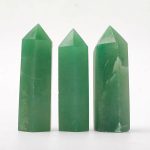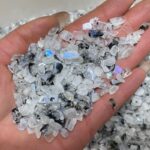Green opaque stones, often described as enigmatic and captivating, have been prized throughout history for their alluring appearance and potential healing properties. Their vibrant green hue and mesmerizing opaque quality have made them popular in jewelry, decorative arts, and spiritual practices. This comprehensive guide will delve into the world of green opaque stones, exploring their fascinating characteristics, diverse applications, and purported therapeutic benefits.

Characteristics of Green Opaque Stones
Green opaque stones derive their distinctive appearance from their chemical composition and molecular structure. They primarily consist of minerals such as jadeite, serpentine, and aventurine, which contain trace elements that impart their characteristic green color. The opaque nature of these stones results from the presence of microscopic crystals or inclusions that scatter light, preventing it from penetrating through the stone.
According to the Gemological Institute of America (GIA), the most common green opaque stones include:
| Stone | Chemical Composition | Mohs Hardness |
|---|---|---|
| Jadeite | NaAlSi2O6 | 6.5 – 7 |
| Serpentine | Mg3Si2O5(OH)4 | 3.5 – 5 |
| Aventurine | SiO2 | 7 |
Historical and Cultural Significance
Green opaque stones have played a significant role in various cultures across the globe. In ancient China, jadeite was highly revered and considered a symbol of good luck, prosperity, and longevity. It was used extensively in ceremonial objects, ornaments, and decorative carvings.
In ancient Egypt, green serpentine was believed to possess protective powers and was often used to create amulets and talismans. The Egyptians also associated this stone with the goddess Isis, who was known as the protector of women and children.
Native American cultures also highly valued green opaque stones, particularly turquoise. Turquoise was considered a sacred stone that symbolized the sky and water. It was used in jewelry, ornaments, and ritual objects.
Applications in Jewelry and Decorative Arts
Due to their captivating aesthetics, green opaque stones are frequently employed in jewelry making. Jadeite, in particular, is highly sought after for its striking green color and durability. It is commonly used in necklaces, bracelets, earrings, and pendants.
Serpentine is another popular choice for jewelry making due to its affordable nature and distinct dark green color. It is often used in carved pieces, beads, and cabochons. Aventurine, with its shimmering green hue, is a favorite for gemstone earrings, bracelets, and rings.
In decorative arts, green opaque stones are used to create intricate carvings, sculptures, and mosaics. Jadeite is renowned for its exceptional ability to hold detail, making it ideal for highly detailed carvings. Serpentine is also used in decorative carvings, often depicting animals or mythical creatures.
Potential Therapeutic Benefits
Throughout history, green opaque stones have been associated with numerous therapeutic properties. In traditional Chinese medicine, jadeite is believed to promote vitality, longevity, and emotional balance. It is said to have a calming effect and aid in the circulation of qi (life energy).
Serpentine is traditionally used for its purported ability to reduce stress, anxiety, and inflammation. It is also believed to be beneficial for the digestive system and skin health.
Aventurine is associated with positive energy, optimism, and creativity. It is said to enhance willpower, determination, and motivation.
Common Pain Points and Motivations
Individuals considering using green opaque stones for therapeutic purposes may encounter several pain points and motivations:
Pain Points:
- Lack of scientific evidence to support many purported healing claims
- Potential for allergic reactions or skin irritations
- Ethical concerns regarding the sourcing and mining of some stones
Motivations:
- Desire for natural and holistic healing methods
- Search for spiritual or emotional support
- Belief in the power of gemstones for therapeutic purposes
How to Approach Using Green Opaque Stones for Therapeutic Purposes
If considering incorporating green opaque stones into a therapeutic regime, it is essential to proceed with caution and follow these steps:
- Research: Gather information from credible sources to gain an understanding of the purported benefits and potential risks associated with using green opaque stones.
- Consultation: Seek guidance from a qualified health practitioner or gemstone therapist to discuss individual needs and determine if green opaque stones are a suitable option.
- Cautious Approach: Start with small exposures to the stones and gradually increase usage over time. Monitor for any adverse reactions or discomfort.
- Combine with Other Therapies: Consider integrating green opaque stones with other complementary therapies, such as meditation, yoga, or acupuncture, to enhance potential benefits.
Table 1: Physical Properties of Common Green Opaque Stones
| Property | Jadeite | Serpentine | Aventurine |
|---|---|---|---|
| Color | Deep green to light green | Dark green to yellowish green | Green with golden or blue shimmer |
| Hardness (Mohs) | 6.5 – 7 | 3.5 – 5 | 7 |
| Transparency | Opaque | Opaque | Opaque |
| Density (g/cm3) | 3.34 – 3.39 | 2.55 – 2.75 | 2.61 – 2.67 |
| Refractive Index | 1.65 – 1.67 | 1.55 – 1.57 | 1.53 – 1.54 |
Table 2: Potential Therapeutic Benefits of Green Opaque Stones
| Stone | Purported Benefits |
|---|---|
| Jadeite | Vitality, longevity, emotional balance |
| Serpentine | Stress reduction, anxiety relief, digestive health |
| Aventurine | Positive energy, optimism, creativity |
Table 3: Common Pain Points and Challenges Associated with Using Green Opaque Stones for Therapeutic Purposes
| Pain Point | Challenge |
|---|---|
| Lack of Scientific Evidence | Difficulty in obtaining conclusive scientific support for purported healing claims |
| Potential for Allergic Reactions | Individuals with sensitive skin may experience allergic reactions or irritation |
| Sourcing and Mining Ethics | Concerns regarding the sustainable and ethical sourcing of certain gemstones |
Table 4: Common Mistakes to Avoid
| Mistake | Consequence |
|---|---|
| Relying Solely on Gemstones for Healing | Neglecting other essential aspects of health and well-being |
| Excessive Use | Potential for adverse reactions or diminished therapeutic effects |
| Misinformation | Relying on unsubstantiated or exaggerated claims |




























